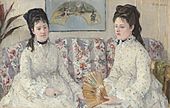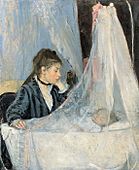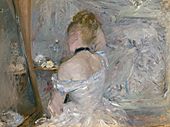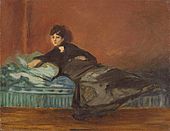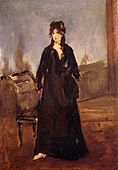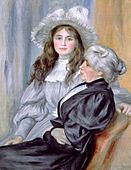Berthe Morisot facts for kids
Quick facts for kids
Berthe Morisot
|
|
|---|---|

Berthe Morisot
|
|
| Born |
Berthe Marie Pauline Morisot
January 14, 1841 |
| Died | March 2, 1895 (aged 54) Paris, France
|
| Resting place | Cimetière de Passy |
| Nationality | French |
| Known for | Painting |
|
Notable work
|
|
| Movement | Impressionism |
| Spouse(s) |
Eugène Manet
(m. 1874; died 1892) |
Berthe Morisot (born January 14, 1841 – died March 2, 1895) was a famous French painter. She was a key member of the group of artists in Paris known as the Impressionists.
In 1864, Berthe Morisot showed her art for the first time at the important Paris Salon. This was a big art show supported by the government. Her paintings were chosen for six more Salons. But in 1874, she decided to join the "rejected" Impressionists. They held their own first exhibition. Other famous artists like Paul Cézanne, Edgar Degas, Claude Monet, Camille Pissarro, Pierre-Auguste Renoir, and Alfred Sisley were also part of this show. Morisot took part in almost all of the Impressionist exhibitions that followed, from 1874 to 1886.
Berthe Morisot was married to Eugène Manet. He was the brother of her good friend and fellow artist, Édouard Manet.
An art critic named Gustave Geffroy called her one of "les trois grandes dames" (the three great ladies) of Impressionism in 1894. The other two were Marie Bracquemond and Mary Cassatt.
Contents
- Berthe Morisot's Early Life and Family
- Berthe Morisot's Painting Style and Techniques
- What Made Her Art Special?
- What Did Berthe Morisot Paint?
- Berthe Morisot and Impressionism
- Berthe Morisot's Personal Life
- Berthe Morisot's Famous Artworks
- Gallery
- Portraits of Berthe Morisot
- Berthe Morisot's Art in the Market
- Berthe Morisot's Legacy
- Exhibitions of Berthe Morisot's Art
- See also
Berthe Morisot's Early Life and Family
Berthe Morisot was born on January 14, 1841, in Bourges, France. Her family was wealthy and well-known. Her father, Edmé Tiburce Morisot, was a high-ranking government official. He also studied architecture. Her mother, Marie-Joséphine-Cornélie Thomas, was related to Jean-Honoré Fragonard. He was a very famous painter from an earlier time.
Berthe had two older sisters, Yves and Edma, and a younger brother, Tiburce. Her family moved to Paris in 1852 when she was a child.
How Berthe Morisot Learned to Paint
It was common for girls from wealthy families to learn art at home. So, Berthe and her sisters, Yves and Edma, had private art teachers. They first started lessons to make a drawing for their father's birthday. In 1857, one of their teachers, Joseph Guichard, took Berthe and Edma to the Louvre art museum. From 1858, they learned by copying famous paintings there. The Morisot sisters were not allowed to work at the museum alone. They also could not get formal art training like male artists.
Berthe and her sister Edma worked closely on their art until 1869. That's when Edma got married and moved away. She then had less time for painting. Letters between the sisters show how much they loved each other. Berthe missed painting with Edma, and Edma always supported Berthe's art.
While copying paintings at the Louvre, Morisot met other artists like Manet and Monet. In 1861, she met Jean-Baptiste-Camille Corot. He was a very important landscape painter. Corot taught her to paint plein air, which means painting outdoors. By 1863, she was also studying with another outdoor painter, Achille Oudinot.
Berthe Morisot's Painting Style and Techniques
Berthe Morisot's art changed over time. She often destroyed her early works because she wasn't happy with them.
Early Years: Learning the Basics (1857–1870)
In her first art lessons, Morisot learned basic drawing. Later, she focused on drawing old classical figures. When she wanted to paint outdoors, her teachers sent her to study with Corot. She used watercolors for outdoor painting because they were easy to carry. She also became interested in pastels.
Working with Watercolors (1870–1874)
During this time, Morisot found oil painting difficult. She mostly used watercolors. She chose soft colors, but she repeated hues carefully to make her paintings balanced. Watercolors helped her create a light, airy feeling in her art. This gave her paintings a fresh look.
Becoming an Impressionist (1875–1885)
Morisot became more confident with oil painting. She worked with oils, watercolors, and pastels at the same time, just like Degas. She painted very quickly. But she did many sketches first. This allowed her to paint "a mouth, eyes, and a nose with a single brushstroke." She knew her subjects well because they were often from her own life.
Changing Her Focus (1885–1887)
After 1885, drawing became more important in Morisot's art. She tried new things with charcoal and colored pencils. Her Impressionist friends were known for blurring shapes. But Morisot started to focus on making forms and lines clearer. She was also influenced by photography and Japanese art. She learned to place objects away from the center of her paintings, like in Japanese prints.
Combining Styles (1887–1895)
Later, Morisot used a technique called "squaring" to transfer her drawings to canvas exactly. This helped her create more complex scenes with figures interacting. She focused on the overall picture and the shapes. Yet, her Impressionist brushstrokes, which were light and quick, remained. She combined her soft, light brushwork with clear lines. This made her later paintings very special.
What Made Her Art Special?
Because she was a female artist, some male critics said her paintings had "feminine charm." They praised their elegance and lightness. In 1890, Morisot wrote that she wished men would treat her as an equal artist. She felt she was just as good as they were.
Her light brushstrokes made critics say she "touched lightly" or "brushed against" the canvas. Early in her career, she painted outdoors to capture what she saw. Around 1880, she started painting on canvases that weren't prepared with a base layer. This made her brushwork even looser. After 1885, she often made drawings first before starting her oil paintings. Her artworks were almost always small.
Morisot used color to create a feeling of space and depth. Even though she used a limited range of colors, other Impressionists called her a "color expert." She often used a lot of white, sometimes pure white or mixed with other colors. This created a sense of lightness and see-through quality.
She learned from Manet and Degas to use very little color when creating a main idea. She also used slightly tinted whites to make her paintings feel balanced. Like Degas, she often used watercolor, pastel, and oil paints in one artwork. Later in her career, she learned from Renoir. She tried to balance how many figures were in her paintings with the light and atmosphere.
What Did Berthe Morisot Paint?
Morisot painted what she saw every day. Most of her paintings show scenes from home: family, children, women, and flowers. These pictures show what women's lives were like in the late 1800s. Instead of public places, Morisot preferred private, quiet scenes. This was partly because of the rules for women in her social class.
Like her fellow Impressionist Mary Cassatt, Morisot focused on home life and portraits. She used her family and friends, like her daughter Julie and sister Edma, as models. By painting her daily life, she seemed to want to capture moments that would otherwise disappear. When she painted flowers, she used them to celebrate womanhood.
Before the 1860s, Morisot painted landscapes. Then she started painting scenes of modern women's lives. Paintings like The Cradle (1872) showed new trends in baby furniture. This showed her interest in fashion and advertising, which her female viewers would have noticed. Her works also include landscapes, gardens, boating scenes, and themes of boredom. Later in her career, she painted more complex subjects. In her last works, she often looked back at memories from her youth and her friends who had passed away.
Berthe Morisot and Impressionism

Morisot first showed her paintings at the Salon de Paris in 1864 when she was 23. Two of her landscape paintings were accepted. She continued to show her work at the Salon and received good reviews until 1873. The next year, she joined the first Impressionist exhibition. She showed her art with the Impressionists from 1874 onwards. She only missed the exhibition in 1878 when her daughter was born.
Some critics thought Impressionism, with its bright colors and focus on quick feelings, was a "feminine" style. They believed it suited women's "weaker temperaments" and "greater sensibility."
During Morisot's 1874 exhibition with artists like Monet and Manet, a critic wrote that the Impressionists were "five or six lunatics of which one is a woman." He said her "feminine grace" was still there even among the "wild ideas" of the group.
Morisot's career really took off in 1872. A private art dealer named Durand-Ruel bought 22 of her paintings. In 1877, a critic called her the "one real Impressionist in this group." She chose to exhibit her art using her full maiden name, Berthe Morisot. She did not use a fake name or her married name. As her skills improved, many people changed their minds about her art. By the 1880 exhibition, many reviews said Morisot was among the best artists.

Berthe Morisot's Personal Life
Berthe Morisot came from an important family. Her father was a government official, and her great-aunt was the famous Rococo artist Jean-Honoré Fragonard.
She met her good friend and fellow artist, Édouard Manet, in 1868. Through Manet, Morisot met and married Édouard's brother, Eugène Manet, in 1874. On November 14, 1878, she had her only child, a daughter named Julie Manet. Julie often posed for her mother and other Impressionist artists, including Pierre-Auguste Renoir and her uncle Édouard.
Letters between Morisot and Édouard Manet show they cared for each other deeply. Manet even gave her an easel as a Christmas gift. Morisot often posed for Manet. There are several famous portraits of her by him, like Repose (Portrait of Berthe Morisot) and Berthe Morisot with a Bouquet.
Berthe Morisot died on March 2, 1895, in Paris. She caught pneumonia while caring for her daughter Julie, who was also sick. Julie became an orphan at 16 years old. Morisot was buried in the Cimetière de Passy.
Berthe Morisot's Famous Artworks
Here are some of Berthe Morisot's well-known paintings:
- Étude, 1864
- Chaumière en Normandie, 1865
- La Seine en aval du pont d'Iéna, 1866
- La Rivière de Pont Aven à Roz-Bras, 1867
- Bateaux à l'aurore, 1869
- Jeune fille à sa fenêtre, 1869
- Madame Morisot et sa fille Madame Pontillon (La Lecture), 1869–1870, National Gallery of Art, Washington, D.C.
- Le Port de Cherbourg, 1871
- Vue de paris de hauteurs du Trocadéro, 1871, Santa Barbara Museum of Art, California
- Femme et enfant au balcon, 1871–72, Art Institute of Chicago
- Intérieur, 1871
- Portrait de Madame Pontillon, 1871, Musée d'Orsay
- L'Entrée du port, 1871
- Madame Pontillon et sa fille Jeanne sur un canapé, 1871, National Gallery of Art, Washington
- Jeune fille sur un banc (Edma Pontillon), 1872
- Cache-cache, 1872
- Le Berceau (The Cradle), 1872, Musée d'Orsay, Paris
- La Lecture (Edma lisant), also called L'Ombrelle verte, 1873, Cleveland Museum of Art, Ohio
- Sur la plage des Petites-Dalles, 1873, Virginia Museum of Fine Arts, Richmond, Virginia
- Madame Boursier et sa fille, 1873, Virginia Museum of Fine Arts
- Le Village de Maurecourt, 1873
- Coin de Paris vu de Passy, 1873
- Sur la terrasse, 1874, Musée du Petit Palais, Paris
- Portrait de Madame Hubbard, 1874, Ordrupgaard museum de Copenhagen
- Femme et enfant au bord de la mer , 1874
- Percher de blanchisseuses , 1875, National Gallery of Art, Washington D.C.
- Jeune fille au miroir, 1875
- Scène de port dans l'île de Wight, 1875
- Eugène Manet à l'île de Wight, 1875
- Avant d'un yacht, 1875, Sterling and Francine Clark Art Institute, Williamstown, Massachusetts
- Femme à sa toilette, 1875
- Femme à sa toilette , 1875–1880, Art Institute of Chicago
- Portrait de femme (Avant le théâtre), 1875
- Jeune femme au bal also called Jeune femme en toilette de bal, 1876, Musée d'Orsay
- Au Bal or Jeune fille au bal, 1875, Musée Marmottan-Monet, Paris
- Jeune Femme arrosant un arbuste, 1876, Virginia Museum of Fine Arts, Richmond, Virginia
- Le Corsage noir , 1876, National Gallery of Ireland, Dublin
- Le Psyché, 1876, Thyssen-Bornemisza Museum, Madrid
- Rêveuse, 1877, Nelson-Atkins Museum of Art, Kansas City, Missouri
- L'Été, also called Jeune femme près d'une fenêtre 1878, Musée Fabre, Montpellier
- Jeune feme assise, 1878–1879
- Jeune fille de dos à sa toilette, also called Femme à sa toilette 1879, Art Institute of Chicago
- Le Lac du Bois de Boulogne (Jour d'été), 1879, National Gallery, London
- Dans le jardin (Dames cueillant des fleurs), 1879, Nationalmuseum Stockholm
- Jeune femme en toilette de bal (Young Woman in Evening Dress), 1879, Musée d’Orsay, Paris
- Hiver, 1880, Dallas Museum of Art
- Deux filles assises près d'une table, 1880
- Bateaux sur la Seine. c. 1880
- Plage à Nice 1881–1882, Nationalmuseum Stockholm
- Le Port de Nice, 1881–1882
- Le Thé, 1882, Fondation Madelon Vaduz, Liechtenstein
- La Fable, 1883
- Le Jardin (Femmes dans le jardin) (1882–1883), Sara Lee Corporation, Chicago
- Eugène Manet et sa fille au jardin 1883
- Dans le jardin à Maurecourt, 1883, Toledo Museum of Art
- Le Quai de Bougival, 1883, Nasjonalgalleriet, Oslo
- Julie et son bateau (Enfant jouant), 1883
- La Meule de foin 1883
- Dans la véranda, 1884
- Julie avec sa poupée, 1884
- Petite fille avec sa poupée (Julie Manet), 1884
- Sur le lac, 1884
- The Artist's Daughter, Julie, with her Nanny, c. 1884, Minneapolis Institute of Art
- Autoportrait, 1885, Art Institute of Chicago
- Autoportrait avec Julie, 1885
- Jeune femme assise au Bois de Boulogne, 1885, Metropolitan Museum of Art, New York City
- La Forêt de Compiègne, 1885, Art Institute of Chicago
- Le Bain (Jeune file se coiffant), 1885–1886, Art Institute of Chicago
- Dans la salle à manger, 1885–1886, National Gallery of Art
- Le Lever, 1886, collection Durand-Ruel
- Intérieur à Jersey (Intérieur de cottage), 1886, Musée communal des beaux-arts d'Ixelles
- Femme s'essuyant, 1886–1887
- Julie avec un chat, 1887, National Gallery of Art, Washington
- Nu de dos, 1887
- Éventail en médaillon, 1887
- Portrait de Paule Gobillard, 1887, Reader's Digest Association, New York
- Le Lac du Bois de Boulogne, 1887, National Museum of Women in the Arts, Washington
- Fillette lisant (La lecture), 1888, Museum of Fine Arts (St. Petersburg, Florida)
- Berthe Morisot and Julie Manet, c.1888–1890, Minneapolis Institute of Art, Minneapolis
- La Cueillette des oranges, 1889, Musée d'art et d'histoire de Provence, Grasse
- Sous l'oranger (Julie), 1889
- L'Île du Bois de Boulogne, 1889, National Gallery of Art, Washington
- Le Flageolet (Julie Manet et Jeanne Gobillard), 1891
- Le Cerisier 1891, 1891
- Étude pour Le Cerisier, 1891, The Reader's Digest Association
- Julie Manet avec son lévrier, 1893, Musée Marmottan-Monet, Paris
- Les Enfants de Gabriel Thomas, 1894, Musée d'Orsay, Paris
- La Coiffure, 1894, Museo Nacional de Bellas Artes (Buenos Aires)
- Jeune fille aux cheveux noirs, 1894, Philadelphia Museum of Art, Philadelphia
Gallery
-
The Sisters, 1869, National Gallery of Art
-
The Artist's Sister at a Window, 1869, National Gallery of Art
-
L'ombrelle verte, Reading (portrait of Edma Morisot), 1873, Cleveland Museum of Art
-
Le Berceau (The Cradle), 1872, Musée d'Orsay
-
Suspendre le linge pour sécher (Hanging the Laundry out to Dry), 1875, National Gallery of Art
-
Eugène Manet on the Isle of Wight, 1875, Musée Marmottan Monet
-
Jour d'été Summer's Day, 1879, National Gallery, London Alternative title: French: Le Lac du bois de Boulogne The Lake in the Bois de Boulogne
-
The Artists' Daughter Julie With Her Nanny, c.1884, Minneapolis Institute of Art
-
The Bath (Girl Arranging Her Hair), 1885–86, Clark Art Institute
-
In the Dining Room, 1886, National Gallery of Art
-
Woman at her Toilette, 1875, The Art Institute of Chicago
-
Julie Manet et son Lévrier Laerte, 1893, Musée Marmottan Monet
Portraits of Berthe Morisot
-
Detail from The Balcony by Édouard Manet, with the portrait of Berthe in the foreground, 1868
-
Berthe Morisot posing for The Rest, 1870, by Édouard Manet
-
Berthe Morisot au soulier rose, 1872, by Édouard Manet. Hiroshima Museum of Art
-
Berthe Morisot and her daughter Julie Manet, 1894, by Pierre-Auguste Renoir
-
Berthe Morisot, 1892, by Renoir
Berthe Morisot's Art in the Market
Berthe Morisot's paintings sold quite well. In 1875, two of her artworks sold for the highest prices at an auction. Her painting Interior (Young Woman with Mirror) sold for 480 francs. Her pastel On the Lawn sold for 320 francs. Her works usually sold for about 250 francs, which was a good price at the time.
In February 2013, Morisot became the highest-priced female artist ever. Her painting After Lunch (1881) sold for $10.9 million at an auction. This painting shows a young redhead in a straw hat and purple dress. It sold for about three times more than expected!
Berthe Morisot's Legacy
Berthe Morisot's life and art have inspired many.
- She was played by actress Marine Delterme in a French TV movie in 2012.
- A character in Elizabeth Kostova's book The Swan Thieves is largely based on Morisot.
- In 1990, an article in the New York Times called her "A First Impressionist."
- Melissa Burdick Harmon, an editor at Biography magazine, noted that Morisot's paintings of babies were considered very personal at the time. This is because things related to infants were seen as part of women's private world.
- In 2019, the Musée d'Orsay in Paris held a special exhibition to honor her work.
Exhibitions of Berthe Morisot's Art
Berthe Morisot's paintings have been shown in many exhibitions around the world. Here are some of her solo shows:
| Selected Berthe Morisot Solo Exhibitions | Date |
| Paris, Boussod, Valadon et Cie. Exposition de tableaux, pastels et dessins par Berthe Morisot. | 1892, May 25 – June 18 |
| Paris, Galerie Durand-Ruel. Berthe Morisot (Madame Eugene Manet): exposition de son œuvre. | 1896, March 5–23 |
| Paris: Galerie Durand-Ruel. Exposition Berthe Morisot. | 1902, April 23 – May 10 |
| Paris, Galerie E. Druet. Exposition Berthe Morisot. | 1905, January–February |
| Paris, Galerie Manzi-Joyant. Exposition Berthe Morisot. | 1912 |
| Paris. Galerie Manzi-Joyant. Exposition Berthe Morisot. | 1914, April |
| Paris, Galerie Bernheim-Jeune. Cent oeuvres de Berthe Morisot (1841–1895). | 1919, November 7–22 |
| Paris, Galerie Marcel Bernheim. Réunion d'oeuvres, par Berthe Morisot. | 1922, June 20 – July 8 |
| Chicago, Arts Club of Chicago. Exposition of Paintings by Berthe Morisot. | 1925, January 30 – March 10 |
| London, Ernest Brown & Phillips, The Leicester Galleries. Berthe Morisot Exhibition | 1930, March–April |
| New York, Wildenstein Galleries. Berthe Morisot Exhibition. | 1936, November 24 – December 12 |
| Paris, Musée de l'Orangerie. Berthe Morisot, 1841–1895. | 1941, Summer |
| Paris, Galerie Weil. Berthe Morisot, retrospective. | 1947 |
| Copenhagen, NY Carlsberg Glyptotek. Berthe Morisot, 1841–1895: Mälningar: Olja och Akvarellsamt Teckningar. | 1949, August 20 – October 23 |
| Boston, Museum of Fine Arts, Boston. Berthe Morisot: Drawings, Pastels, Watercolors. | 1960, October 10 – December 10 |
| Paris, Musée Jacquemart-Andre, lnstitut de France. Berthe Morisot. | 1961 |
| Paris, Galerie Hopkins-Thomas. Berthe Morisot. | 1987–88, April – May 9 |
| London, JPL Fine Arts. Berthe Morisot (1841–1895). | 1990–91, November 7 – January 18 |
| Paris, Galerie Hopkins Thomas. Berthe Morisot. | 1993, October 15 – November 30 |
| Lille, the Palais des Beaux-Arts, Berthe Morisot | 2002, March 10 – June 9 |
| Washington DC, National Museum of Women in the Arts, Berthe Morisot: An Impressionist and Her Circle | 2005, January 14 – May 8 |
| Spain, Madrid, Museo Thyssen-Bornemisza, Berthe Morisot: The Woman impressionist | 2012, November 15 – February 12 |
| Québec, The Musée National des Beaux-arts du Québec, Berthe Morisot: Woman Impressionist | 2018, June 21 – September 23 |
| London, Dulwich Picture Gallery, Berthe Morisot: Shaping Impressionism | 2023, March 31 - September 10 |
See also
 In Spanish: Berthe Morisot para niños
In Spanish: Berthe Morisot para niños
- Women artists
- Western painting
- History of painting
- Julie Manet





